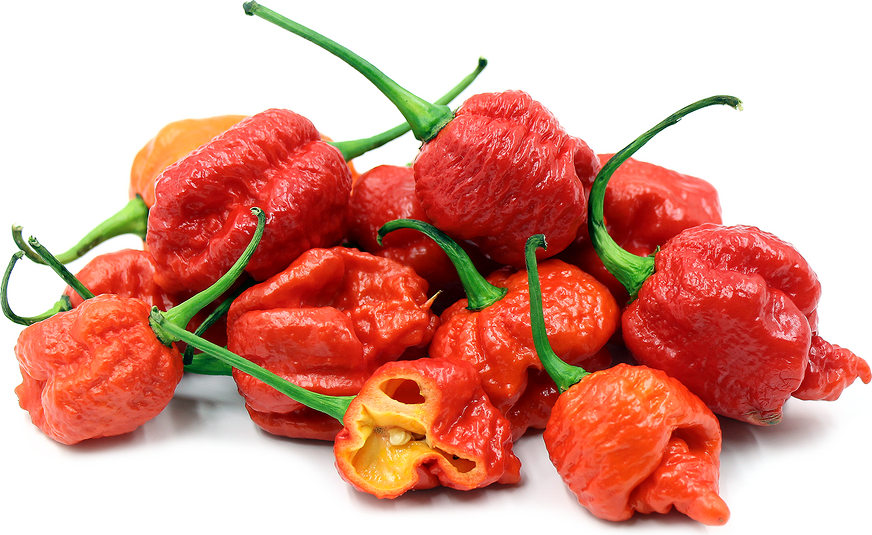


Carolina Reaper Chile Peppers
Estimated Inventory, 8 ct : 2.63
This item was last sold on : 07/31/25
Description/Taste
Carolina Reaper chile peppers can widely vary in appearance depending on the soil and climate they are grown in. Most commonly found in an oblong shape with a signature “scorpion’s tail” or defined point on the non-stem end, Carolina Reaper chile peppers average 2 to 5 centimeters in diameter and 5 to 7 centimeters in length. The pods are deeply wrinkled, creased, and twisted into gnarled shapes and the skin matures from green to bright red with a blistered, glossy appearance. Underneath the surface, the flesh is crisp and aqueous containing a few round and flat, cream-colored seeds. Carolina Reaper chile peppers have a sweet, fruity taste with hints of cinnamon and chocolate, followed by a very intense heat that continues to build and lingers in the throat.
Seasons/Availability
Carolina Reaper chile peppers are available in the mid-summer through fall.
Current Facts
Carolina Reaper chile peppers, botanically classified as Capsicum chinense, are small, gnarled, and very hot pods that are members of the Solanaceae or nightshade family. Also known as HP22B, Carolina Reaper chile peppers were created by crossing a Pakistani naga viper with a sweet, red habanero pepper and were initially developed to create a sweet variety with spicy attributes. While Carolina Reaper chile peppers did develop a very sweet flavor, they also became one of the hottest varieties of pepper in the world, averaging 1,569,300 SHU on the Scoville scale. The pungent peppers have even been recorded to peak to 2,200,000 SHU, which is comparable and sometimes slightly higher to the strength of pepper spray. Carolina Reaper chile peppers are one of the hottest commercially available varieties and are used sparingly in hot sauces and salsas.
Nutritional Value
Carolina Reaper chile peppers are an excellent source of vitamin C, which is an antioxidant that can help protect the immune system. The peppers also contain a very high amount of the chemical compound known as capsaicin, which triggers pain receptors in our body to feel the sensation of burning. Capsaicin has been shown to have anti-inflammatory properties and causes the body to release endorphins to counteract the perceived pain.
Applications
Carolina Reaper chile peppers are most commonly added to hot sauces or salsas as a sweet flavoring and intense heat. When blended into sauces, the peppers can be used to flavor chicken wings, cooked meats, pasta, Asian noodle dishes, chilis, stews, and soups. Carolina Reaper chile peppers can also be dried and ground into a powder and used as a spice. When handling fresh peppers, it is important to wear gloves to protect the skin from the potent capsaicin and if blending, use protective eyewear. Carolina Reaper chile peppers are scorching, and caution should be taken before consuming the pods as the peppers can cause visceral reactions within the body. The peppers will keep 1-2 weeks when loosely wrapped in plastic and stored whole and unwashed in the refrigerator.
Ethnic/Cultural Info
When the Carolina Reaper was first being developed, the pepper was initially named HP22B, which stood for higher power, pot number 22, and plant B, a designation for creator Ed Currie to keep track of his genetic crossings. Once the pepper was fully developed and ready for distribution, it was named after its similarity in shape to the grim reaper’s scythe. This “deadly” name encouraged self-proclaimed “chile heads” to try the pepper and endure the excruciating heat. Carolina Reaper chile peppers were initially tested at Winthrop University in 2010, where they received their first Scoville rating of 1,474,000 units, eventually earning it a place in the Guinness Book of World Records in 2013. Since then, the average rating of the Carolina Reaper has increased and has at times peaked well above 2,000,000 Scoville units. Over the past ten years, as more and more hot chiles are bred and developed, the title for world’s hottest has changed hands several times.
Geography/History
Carolina Reaper chile peppers were developed in South Carolina by Ed Currie, owner, and operator of the PuckerButt Pepper Company. Also known as “Smokin Ed,” Currie created the Carolina Reaper from a cross between a Pakistani naga viper with a sweet, red habanero pepper. After extensive breeding trials and ten years of cultivation, the Carolina Reaper was officially named in 2012. Carolina Reaper chile peppers are not sold in commercial markets and are predominately a specialty variety grown for home gardening. Seeds are available through specific online catalogs in the United States, Europe, and Australia, and there are many hot sauce varieties sold online that use the pepper as one of the ingredients.
Featured Restaurants
Restaurants currently purchasing this product as an ingredient for their menu.
| Matsu | Oceanside CA | 760-717-5899 |
Recipe Ideas
Recipes that include Carolina Reaper Chile Peppers. One
| Sugar Dish |
|
Cherry Bomb Chicken |
| Chili Pepper Madness |
|
The Hottest Damn Hot Sauce I've Ever Made! |
| Adriana's Best Recipes |
|
Roasted Carolina Reaper Salsa |




